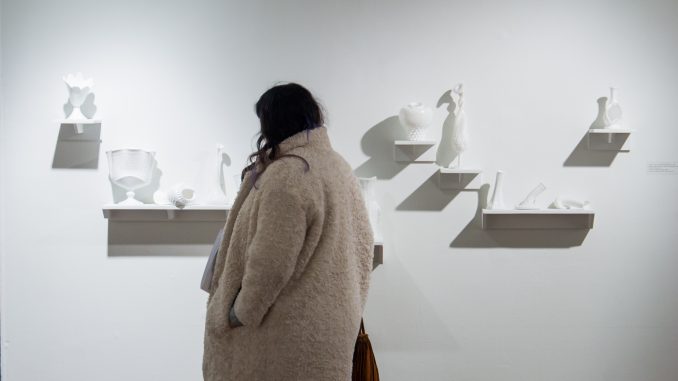
For Jessica Jane Julius’ 3-year-old son, anything that lights up is a touch screen.
“Anything that’s lit a little bit, he’s touching it, because that’s now what we’re kind of living with,” said Julius, an adjunct assistant professor in the Tyler School of Art’s glass program. “We are a screen-based culture.”
Julius, along with three other Tyler professors, decided to take a step back from this new culture and reflect on the digital age in a collaborative art exhibition titled “HUSH.” The exhibition, featuring grayscale glass sculptures, installations and drawings, opened Jan. 28 at the Philadelphia Art Alliance, at 251 S. 18th St.
Julius worked with professors Amber Cowan, Megan Biddle and Sharyn O’Mara, all part of Tyler’s glass program, to create the exhibition.
Melissa Caldwell, the chief curator at the Art Alliance, said “HUSH” was a more hands-off curating experience for her, because of the teaching and artistic experience of the four artists.
“As faculty members and professional artists, it was just kind of fun for me to watch,” Caldwell said. “They’ve been working so long in the glass world.”
The conceptual creation of “HUSH” began long before its recent debut at the Art Alliance. Cowan, an adjunct professor, said the four artists originally teamed up to fashion the concept for “HUSH” about three years ago after noticing similarities, like the use of repetitive patterns, in some of their works, which were on display in the Temple Contemporary at the time.
With these commonalities in mind, the four Tyler professors teamed up to apply for a competitive residency at the Pilchuck Glass School through the John H. Hauberg Fellowship Program to pursue “HUSH.”
“We actually applied twice and didn’t get it,” Cowan said. “We had brought together this idea of the show for the residency and were like, ‘Well, you know, if we can’t do the residency out there, let’s just do it here and have our own show.’”
The four professors created their own residency at Tyler and worked there, as well as in their own separate studios, throughout this past summer and fall to create “HUSH.”
The exhibition, Cowan said, explores the idea of leaving the digital age behind and returning to analog and handmade processes. “HUSH,” she added, is about “going into more contemplative and quiet viewing.”
“And we were thinking about this as far as the residency, having time to just be away from all the chaos of … teaching and all the chaos that is our world now,” Cowan said.
During their residency, the team melted down gray glass in one of Tyler’s glass melting tanks to share in order to produce cohesive, grayscale pieces.
“Normally at Tyler, we only melt clear glass in our tanks,” Cowan said. “Last semester and over the summer, we melted a gray tank, so we had a whole tank of beautiful gray glass.”
“So we had this tank that all of us could use and unify the work a little bit,” she added.
Cowan and Julius both used this glass in some of their featured works.
Julius’ favorite self-created piece for the show isn’t made of this Tyler-melted gray glass, but airport-grade reflector beads. “Absorption Screen” is a 19-by-19-foot screen of these glass beads.
“I would paint a section and then I’d splash the beads on it,” Julius said. “That piece will only exist for this exhibition. Once it’s done, I will scrape it off of the wall, so there is an ephemeral sense to it too.”
Julius’ temporary creation, which is activated with spotlights, has also become a favorite of Art Alliance patrons.
“I would definitely say because it’s site specific and so large that the ‘Absorption Screen’ is a pretty big hit,” Caldwell said. “They always want to know what it’s made of because it gives off an almost eerie quality, but in a good way.”
Julius said her inspiration for the “Absorption Screen” was television static.
“It’s all the radiation that’s in the air and it gets sucked into your television,” Julius said. “It gets pulled into the television and put into a pictorial sense, an image that we can then look at.”
“And it’s a discarded image,” Julius added. “So there’s something that’s the unwanted in an image-based society I think is interesting.”
“HUSH” will remain on display until April 24, and an artist discussion panel will be held on March 30 at 6 p.m. Glass artist Daniel Clayman will be the moderator, and the four Tyler professors will discuss their work from “HUSH.”
Jenny Roberts can be reached at jennifer.roberts@temple.edu.





Be the first to comment